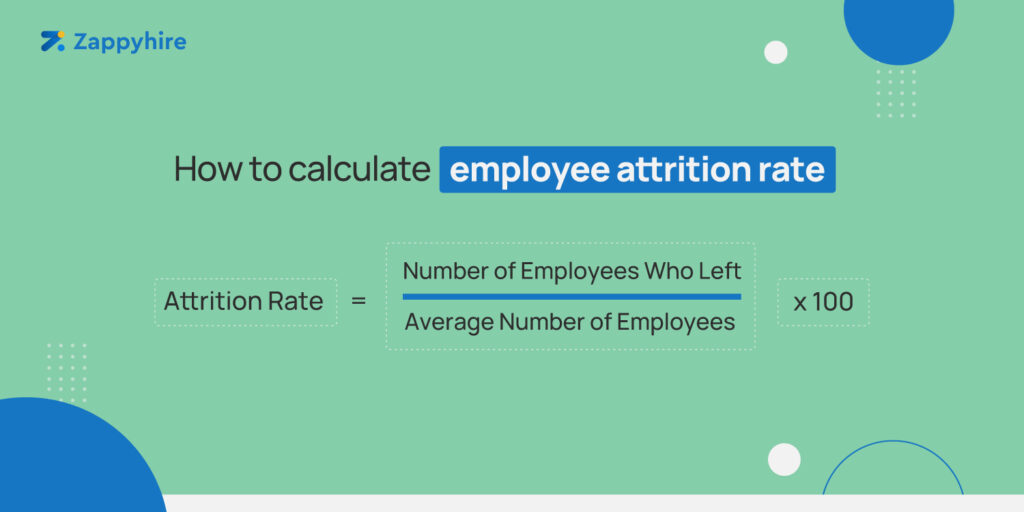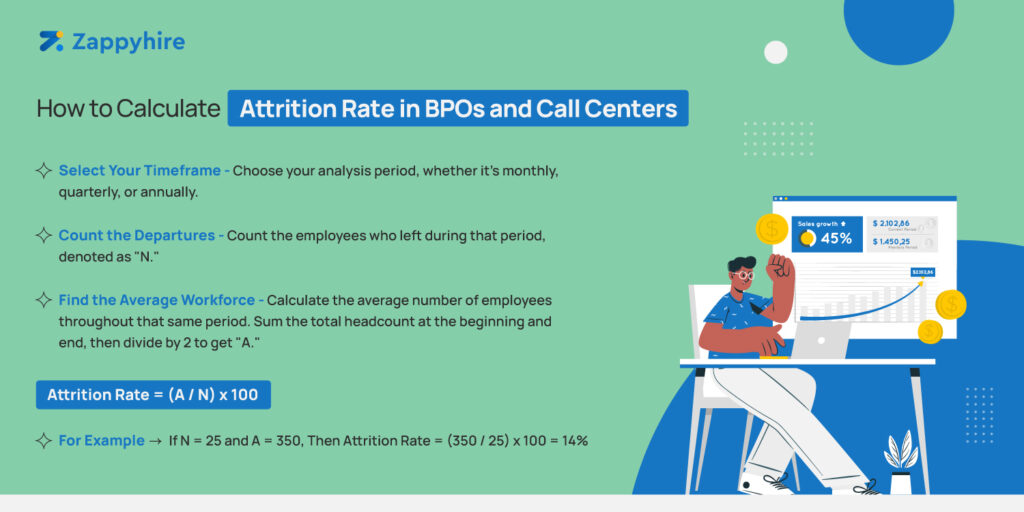
When employees depart like passengers deserting a sinking ship, something is amiss.
For example, in the United States, a staggering 70% of employee turnover is voluntary, suggesting that employees are increasingly willing to leave their jobs in pursuit of better opportunities or improved work conditions.
Attrition rate is the silent company killer. Just when you thought your workforce was stable, it strikes.
But what exactly is this lurking danger, and why does it matter to your organization?
- What is employee attrition rate?
- What causes a high employee attrition rate?
- How to calculate employee attrition rate?
- What is considered a high employee attrition rate?
- Calculating attrition rate formula in the BPO industry
- Calculating attrition rate in the IT industry
- A low employee attrition rate for a healthier, more resilient, and thriving workplace.
What is employee attrition rate?
Attrition rate signifies the percentage of employees who voluntarily or involuntarily leave their jobs within a specified period.
It offers insights into workforce stability and can be a barometer of an organization’s health. A lower attrition rate is often indicative of a contented, committed workforce, whereas a higher rate might signal underlying issues.

This silent killer not only affects the present state of your workforce but also poses challenges in recruitment when potential future candidates notice frequent job vacancies and low reviews on job sites like Glassdoor, reflecting employee dissatisfaction and high attrition rates.
What causes a high employee attrition rate?
1. Work-related fulfillment
Employees who find purpose and meaning in their roles are more likely to stay with an organization.
When the work aligns with their values and provides a sense of accomplishment, they tend to remain committed.
2. Compensation and benefits
Adequate and competitive compensation packages, along with appealing benefits, can be crucial in retaining talent.
A Glassdoor survey found that 67% of employees considered competitive salaries and benefits a primary factor in deciding to stay with their current employer.
Inadequate pay can trigger employees to explore opportunities offering better financial rewards.
3. Work-life balance and well-being
Overworking employees can result in burnout and make them seek work environments that promote a healthier work-life balance.
Companies valuing the well-being of their staff are more likely to maintain a stable workforce.

4. Leadership and workplace culture
Effective management and a positive workplace culture are essential. Toxic leadership styles and negative work cultures can deter employees from staying.
5. Recognition and professional development
Recognizing and rewarding employees’ contributions and offering opportunities for career advancement motivate them to stay.
The absence of recognition and growth prospects can drive them to leave.
6. Hiring the wrong candidates
Beyond the impact on morale and engagement, bad hires or wrong hires can also contribute to attrition, creating a cycle that necessitates tracking Key Performance Indicators (KPIs) to ensure the quality of hires.
How to calculate employee attrition rate
Calculating the attrition rate involves a straightforward formula –

For instance, if during a specific period, 10 employees left a company and the average number of employees was 200, the attrition rate can be calculated as :
Attrition Rate = 10/200 * 100 = 5%
This resulting 5% attrition rate signifies the proportion of employees who left during the period, relative to the average workforce.
What is considered a high employee attrition rate?
While what constitutes a high attrition rate can vary by industry and region, an attrition rate significantly above industry benchmarks is generally considered high.
An attrition rate exceeding 20% is generally considered to be high.
A rate significantly surpassing this average may signal an organization’s struggles to retain its workforce effectively.
High attrition rates can be problematic, as they lead to increased recruitment and training costs and disrupt workflow, ultimately affecting an organization’s bottom line.

According to LinkedIn data, it was found that attrition rate for roles in Human Resources stood at 14.6%, Tech & Media at 12.9%, Retail at 11.4%, and Accommodation and Entertainment shared a rate of 11.8%.
The causes behind this diversity are manifold, encompassing industry-specific dynamics, workplace conditions, compensation packages, and job roles.
Acknowledging these differences is essential for organizations aiming to implement customized strategies for optimal talent retention.
Moreover, the use of an intelligent talent acquisition platform can provide better candidate insights, assessing potential fit, culture fit, and other crucial factors for reducing attrition rates.
Calculating attrition rate formula in the BPO industry
The Business Process Outsourcing (BPO) sector plays a vital role in the global economy, offering a wide range of services to businesses.
A critical metric within this sector is the attrition rate, which gauges the rate at which employees depart from their roles, particularly in call centers and outsourcing organizations.
What is usually considered a high employee attrition in the BPO industry?
The BPO sector typically experiences attrition rates within the range of 30% to 40%, which is considered the industry standard for call center turnover.
However, these rates can be influenced by various factors, including location, company policies, and market conditions.
Attrition rates within call centers are not uniform. Entry-level agents tend to face higher attrition rates, often hovering around 27%, primarily due to the demanding nature of their roles.
In contrast, senior agents may experience attrition rates as low as 12%, reflecting their experience and stability in their positions.
High-stress levels, escalating customer expectations, and the demanding nature of the work are significant contributors to attrition in the BPO sector. Employees in this sector often manage a high volume of customer interactions, making resilience and support critical for retention.
The attrition landscape in the BPO sector exhibits regional variations too.
In India, a prominent hub for BPO operations, attrition rates have been reported to range from 30% to 50%.
These variations can be attributed to a combination of cultural, economic, and organizational factors.
BPO companies actively employ various strategies to mitigate attrition rates.
These strategies include
- Enhancing organizational culture
- Investing in training programs
- Adopting technology
- Focusing on employee engagement, amongst others.
How to calculate attrition rate in BPOs and call centers
Whether dealing with voice or non-voice processes, the methodology remains consistent. Here’s your step-by-step guide on how to accurately calculate attrition rates:
Select Your Timeframe – Begin by determining the specific period for which you want to calculate the attrition rate. This can be on a monthly, quarterly, or annual basis, depending on your analytical requirements.
Count the Departures – During the chosen period, meticulously count the number of employees who have left the organization. This is your “Number of Employees Who Left,” which we’ll denote as “N.”
Find the Average Workforce – Estimate the average number of employees working during the same period. To calculate this, sum up the total headcount at the beginning and end of the chosen timeframe. Next, divide this total by 2 to obtain the “Average Number of Employees,” which we’ll designate as “A.”
Apply the Formula – Utilize the attrition rate formula to perform the calculation. The attrition rate formula in BPO industry is as follows:
Attrition Rate = (A / N) x 100
Let’s illustrate this with an example: If during the specified period, ten employees decided to move on, and the average headcount stood at 350, your attrition rate computation would unfold as follows:
N = 25 A = 350 Attrition Rate = (350 / 25) x 100 = 14%
This final figure of 14% represents your attrition rate for the designated timeframe.

Calculating attrition rate in the IT industry
The IT industry, especially the Indian sector, has been grappling with attrition rates that are raising eyebrows, with major industry players facing substantial employee turnover.
In a stark example, Infosys confronted an attrition rate of 28.4% in the first quarter of the fiscal year 2022-23, the highest among Indian IT giants.
Wipro followed closely with an attrition rate of 23.3%, while Tech Mahindra reported an attrition rate of 22%. TCS, too, saw a spike, reaching 19.7%.

While attrition proves to be a global challenge for IT and BPO service providers, it’s particularly acute in India.
This challenge arises from an unexpected surge in demand during the midst of the pandemic that started in the year 2020, coupled with changing employee expectations, including higher compensation and flexible work environments.
For service providers, the path to addressing the attrition spike lies in reinforcing the employee value proposition, encompassing culture, incentives, and growth opportunities.
Beyond immediate solutions, IT firms are expanding operations and tapping into global talent pools to counteract high attrition rates.
Providers such as Infosys, Accenture, and HCL have successfully implemented this approach, maintaining global attrition rates lower than the average.
A low employee attrition rate for a healthier, more resilient, and thriving workplace
Whether you’re navigating the bustling call center industry or the dynamic world of IT, or even essential fields like medical or teaching – the challenges posed by high attrition rates are real, demanding attention, and proactive solutions.
The significant costs associated with high attrition rates, the impact on customer experience, and the disruption to workflow all underscore its critical importance.
Addressing attrition is not a one-size-fits-all endeavor.
Instead, it involves a combination of efforts, from offering competitive compensation packages to nurturing a supportive work environment and focusing on the professional development of employees.
And HR leaders have the power to bring the changes.





